Dopamine has emerged as a buzzword, especially among Gen Z, sparking widespread discussions on social media platforms. Known as the “feel-good” neurotransmitter, dopamine plays a crucial role in how we experience pleasure, motivation, and reinforcement. Its newfound popularity as a topic of conversation is not just a reflection of increased awareness about mental health but also a testament to the changing landscape of digital culture and marketing.
Dopamine and Its Social Media Spotlight
They tried to tamp the pleasure. They would not eat for days (intermittent fasting). They would eschew screens (digital detox). It was not enough. Life was still so good and pleasurable.
And so they came to the root of it: dopamine, a neurotransmitter that is involved in how we feel pleasure.
How to Feel Nothing Now, in Order to Feel More Later, Nellie Bowles, The New York Times
A few years ago, I wrote about Dopamine Pink and Dopamine Dressing to explain the desire for cheery clothes post-pandemic. The term, Dopamine Dressing, takes its name from the chemical phenomenon in the brain — the chemistry of reacting to happy things. The name stuck because it aptly describes the need behind the trend. We want to feel happy so we look at (and design and buy and curate), bright and whimsical things. Dopamine Pink is by far the most popular color for this trend. As a result, bright and happy colors have become powerful for search, social marketing, and merchandizing. In particular, the following search terms were trending:
- rainbow dress women
- fuchsia dress outfit
- electric blue outfit
- vibrant outfits
- gradient dress
- pink shoes
- color blocking outfits
- emerald green dress
People loved waking up and grabbing bright, colorful clothes to combat the gloom of everyday life.

Source: https://www.papermag.com/grammys-red-carpet-2022
That cheerful feeling was attributed vaguely to dopamine or sometimes serotonin — communicating the idea that these external, consumption habits could alter brain chemistry.
Dopamine’s rise to fame on social media and the concept of dopamine detoxing can be attributed to its connection with the reward mechanisms in our brains. Gen Z, a demographic known for being highly connected and digitally savvy, has embraced discussions about dopamine as part of a broader interest in mental health, wellness, and self-improvement. Platforms like TikTok, Instagram, and Pinterest are buzzing with content related to dopamine detoxes, hacks to boost dopamine levels, and how digital consumption affects our brain chemistry.
These discussions often revolve around the impact of social media itself on dopamine release. The instant gratification of likes, shares, and comments can create a dopamine-driven feedback loop, making users more mindful of their digital habits. Consequently, this awareness has given rise to trends such as “dopamine fasting,” where individuals take breaks from social media and other digital stimuli to reset their brain’s reward system.
Examples
What is Dopamine, exactly?
Dopamine is a neurotransmitter, a type of chemical messenger, that plays several important roles in the brain and body. In neuroscience, dopamine is well-known for its involvement in reward, motivation, and pleasure. It is often referred to as the “feel-good” neurotransmitter because it contributes to the sensation of enjoyment and reinforcement, which motivates a person proactively to perform certain activities. Additionally, dopamine is crucial for regulating movement and emotional responses, and it has functions in controlling the reward and pleasure centers of the brain.
Dopamine in Social Media Context
On social media, the term “dopamine” is often used more casually and metaphorically. People frequently refer to the “dopamine rush” in contexts such as receiving likes on a post, engaging in online shopping, or experiencing the excitement of a new notification. These activities are commonly seen as instant gratification experiences that provide a quick boost of happiness or satisfaction. The term is sometimes used to explain why people are drawn to certain behaviors, implying that these activities trigger a release of dopamine, reinforcing the behavior and creating a cycle of craving and reward.
Comparing Scientific and Social Media Perspectives
When comparing the scientific understanding of dopamine with its portrayal on social media, there are notable differences in depth and accuracy. In neuroscience, dopamine’s role is complex and multifaceted, involving not just pleasure, but also learning, attention, and regulation of mood. It is part of a larger system that influences behavior and well-being. In contrast, social media often simplifies dopamine’s role to merely the feeling of pleasure or a “reward” mechanism. This oversimplification can lead to misconceptions about how dopamine actually functions in the brain.
While the social media portrayal is not entirely inaccurate—dopamine does play a role in reward and pleasure—it lacks the nuance of its broader functions and interactions with other neurotransmitters and brain regions. These simplified explanations are catchy and relatable, making them popular for quick consumption online, but they do not capture the full scientific picture. Understanding dopamine requires acknowledgment of its complexity and the essential role it plays beyond the immediate gratification that social media often emphasizes.
Implications for Marketing
The heightened focus on dopamine has significant implications for marketing strategies targeting Gen Z. As this generation becomes more conscious of their dopamine-driven behaviors, brands need to adapt their approaches to engage with them effectively. Here are a few ways dopamine awareness is shaping marketing:
- Authenticity and Value: Gen Z values authenticity and meaningful interactions. Brands that provide genuine value and engage in transparent communication are more likely to foster positive dopamine responses and build lasting connections.
- Experience Over Materialism: With a growing interest in experiences that enhance well-being, marketers are shifting from purely product-centric messaging to experience-based narratives. This shift aligns with Gen Z’s preference for experiences that evoke positive emotions and memories.
- Mindful Marketing: Emphasizing mental health and wellness, brands are incorporating messages that resonate with the values of self-care and balance. Campaigns promoting offline activities and digital detoxes are gaining traction among this demographic.
Just understanding how young consumers view dopamine is a good starting point for joining the conversation.
Social Media Trends Heading into 2025
As we look forward, the influence of dopamine on social media trends is likely to grow even more pronounced. Here are some anticipated developments:
- Increased Focus on Mental Health: Platforms will continue to integrate features that promote mental health awareness, offering tools for users to monitor their screen time and manage digital consumption.
- Rise of Wellness Content Creators: Influencers and content creators who specialize in wellness, neuroscience, and personal development will gain prominence, providing insights into dopamine management and mental well-being.
- Enhanced Personalization: As technology advances, personalized experiences that align with individual dopamine triggers will become more sophisticated, tailoring content, ads, and interactions to maximize user engagement.
- Collaborative Platforms: The creation of communities centered around shared interests in mental health and dopamine-related topics will foster collaborative platforms, encouraging collective learning and support.
Don’t be surprised if related terms and trends surface as people continue exploring this concept.
The Takeaway
The dopamine trend reflects a deeper shift in how Gen Z interacts with social media and marketing, driven by a desire for authenticity, connection, and well-being. As the conversation around dopamine continues to evolve, so too will the strategies that brands and platforms employ to capture the attention of this influential generation.
Dive Deeper
- A Field Guide to Silicon Valley Self-Denial, Jacob Rosenberg, Mother Jones
- Desire, Dopamine, and the Internet, L. M. Sacasas, The Convivial Society
- Dopamine, explained, Celia Ford, Vox
- Dopamine fasting is Silicon Valley’s hot new trend. Is it backed by science? Sigal Samuel, Vox
- How to Feel Nothing Now, in Order to Feel More Later, Nellie Bowles, The New York Times
- Should we all be dopamine dressing?, Harper’s Bazaar
- What is Dopamine Fasting? Psych Central
- Yes, the internet is destroying our collective attention span, Brian Resnick, Vox
- Dopamine Nation: Finding Balance in the Age of Indulgence By Dr. Anna Lembke

Understand Shopping Trends
We’re dropping our next newsletter in July 2025. Sign up for exclusive freebies, giveaways, and industry insights.



